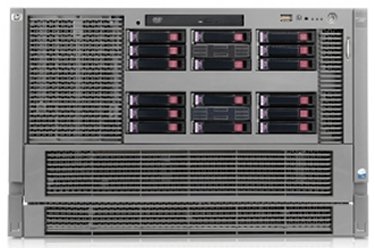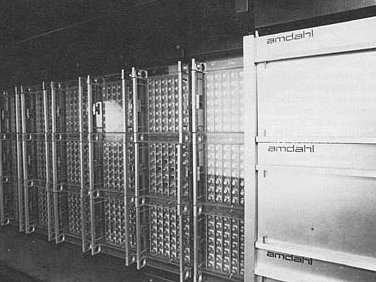
The HP rx6600 four-socket, eight-core server will provide the hardware base for T3's Liberty line of IBM-compatible midrange mainframes
A Joint Assault on the Mainframe Hardware Market
by Hesh Wiener
IT Jungle
September 26, 2006
Two companies are about to launch a joint assault on IBM's mainframe processor market. Platform Solutions [ http://www.platform-solutions.com/ ] has built a series of large-scale computers that can load and run software written for the System z9 and its antecedents. T3 Technologies [ http://www.t3t.com/ ] will incorporate PSI's technology in a line of midrange IBM-compatible mainframes. While these new processors might not break IBM's grip on the mainframe base, they could well inspire IBM to make substantial changes in its mainframe technology.
Platform Solutions is attempting to exploit the proven mainframe compatibility developed by Amdahl (which has long-since been subsumed into long-time investor Fujitsu [ http://www.fujitsu.com ] ), and it has also extended that compatibility to match IBM's current 64-bit processor architecture. The technology is packaged as a firmware system that runs on Intel's Itanium processors, such as Hewlett-Packard's Integrity line of machines.
The Itanium family of processors is designed to work with firmware; its standard instruction set is only one application of the underlying hardware architecture. What this means to PSI is that its products promise to be far more efficient than mainframe emulations in software. In this case, efficiency means that PSI's systems will require fewer processor cycles to execute a mainframe instruction than, for example, an Intel-based system running the Hercules [ http://www.itjungle.com/big/big020706-story01.html ] mainframe emulator.
Platform is also the heir to Amdahl's rights to obtain IBM software licenses, and the legal know-how required to preserve and extend those rights. IBM isn't making much noise about this, but at the most recent SHARE [ http://www.share.org/ ] conference held in August, PSI and a prestigious prospect, Lufthansa [ http://www.lufthansa.com/ [ http://www.lufthansa.com/ ], talked openly about their joint effort. There's quite a difference between an experiment, which is how IBM may view the PSI-Lufthansa demonstration, and the commercial marketing of PSI systems, for which IBM will supply and support its full range of mainframe software products. Initially, PSI is expected to offer processors with power than falls within the wide performance range of the z9 series. Its emphasis will be on competition with IBM's flagship models, the z9 EC group.

The HP rx6600 four-socket, eight-core server will provide the
hardware base for T3's Liberty line of IBM-compatible midrange mainframes
T3 plans to sell machines bearing its own T3 Liberty brand built using PSI firmware and HP's just-announced Integrity rx6600 servers. These HP boxes have four sockets, each able to take a single-core Itanium 2 or dual-core Itanium 9000. Because T3 systems will use the dual-core Itanium 9000s and will be configured to use at least two cores for systems management functions, each box can have one to six cores running in mainframe mode. The machines will match the performance of smaller IBM z9 BC systems. My estimate is that the initial T3 products will deliver 50 to 70 MIPS per core. Single-core configurations will run at something like 70 MIPS, while six-core boxes will run at 300 MIPS, perhaps a bit more, depending on how much computing energy goes up the multiprocessor chimney. I have summarized the basic hardware specifications in this table [ http://www.itjungle.com/big/big092606-story01-fig01.html ].
Both PSI and T3 have made it clear that their systems are not confined to mainframe emulation. Using processor cores not loaded with mainframe firmware and not required for other systems operations, they can run all the software that the underlying servers support when sold directly by HP. That means the server can run Linux, Windows, HP-UX, and Open VMS at the same time as they manage workloads running in any IBM mainframe environment.
Skeptics question the whole concept, pointing out that the plug-compatible manufacturers of the bipolar era were driven out of the market when IBM moved to CMOS. IBM may have even more processor prowess these days. It has its mainframe chips, it has the Power family, it has its game chips (which are cousins of its Power server chips), and it could, if it wished, use Intel Xeon or AMD Opteron circuits to replace, complement, or supplement its System z engines.
This may be more than just a speculative comment. IBM already sells processors that use a mix of processors under one skin to deliver a unified mix of server environments. They are called the System i [ http://www-03.ibm.com/systems/i/ ] product line. Machines in this family run their native i5/OS software, offer support for some workloads that use a standard Power platform, such as AIX and Linux, and can include, as options, integrated X86 processors that support Windows or Linux, too.
But the PSI-on-Itanium solution is distinct from the System i design. The versatile Itanium processors are all the same. Users can move work from one core to another. Users of Series i computers cannot move a Windows-Exchange email subsystem to a native Power processor, since Windows is not supported on Power. Nor can the System i provide processor sparing and failover technology that crosses processor architecture boundaries. The different engines under a System i hood are integrated, but they are not uniform and they do not share all system resources without regard to the architectural mode in which they operate. And then there's the obvious example, mainframes with processor circuits adjusted to provide Linux support and specialty functions such as Java processing.

The Amdahl 470 was the first IBM-compatible mainframe; it sparked
the creation of an entire industry segment
But there's a lot more to the PSI concept, and in particular the implementation of PSI technology that will be offered by T3.
In the PCM era that began in the mid-1970s, Amdahl said its machines were IBM compatible, that they cost less than IBM brand processors. Amdahl said that they were faster, too. Amdahl aimed at users of IBM's biggest systems, customers who always seemed to be hankering for faster engine speed. PSI is aiming at big targets, but for now, least, it will not be offering machines with faster engines than the IBM z9 has, nor will it have more total power in a single box.
There's even more contrast between T3 and the original PCM product strategy. T3's machines will compete with the low end of IBM's mainframe line. These customers aren't running out of MIPS, and if they happen to need an upgrade, it's just a matter of installing fresh firmware. If these users choose a T3 computer over an IBM one, they will be choosing the compatible box because they believe it offers better value and more versatility. Sure, some will like the smaller box; System z9 BC machines show up in huge, mainly empty, cabinets. But that is unlikely to be a decisive or even significant factor in the purchase decision.
So, we'll all have to watch how T3 and PSI position their products, and to see how well they actually do in a market IBM is very keen to keep to itself.
Copyright 2006